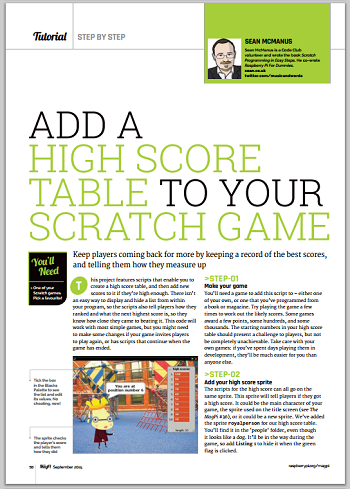
100 Top Tips: Microsoft Excel
Power up your Microsoft Excel skills with this powerful pocket-sized book of tips that will save you time and help you learn more from your spreadsheets.
29 September 2015
 I've been thinking recently about how you can make your Scratch games more professional and complete, and two ideas occurred to me: including a title screen and a high score table. I wrote tutorials on how to do both for The MagPi magazine, the official magazine of the Raspberry Pi. A lot of people who are interested in Scratch aren't online much over the summer (teachers and their students) so I thought I'd wait until the new school term before telling you about them both here. You can download the back issues that include these tutorials for free.
I've been thinking recently about how you can make your Scratch games more professional and complete, and two ideas occurred to me: including a title screen and a high score table. I wrote tutorials on how to do both for The MagPi magazine, the official magazine of the Raspberry Pi. A lot of people who are interested in Scratch aren't online much over the summer (teachers and their students) so I thought I'd wait until the new school term before telling you about them both here. You can download the back issues that include these tutorials for free.
Issue 37 includes my tutorial on adding a high score table to a Scratch game. It uses a list to store the top ten scores and then compares the new score and tells you how you ranked. It should work with most simple games. Download the article PDF here.
Issue 36 included my tutorial on adding a start screen to your Scratch game. I included a simple game for this so that the article could demonstrate the transition between the game and its title screen. The same concept should apply to most simple games. The article includes tips on patching the title screen in, in place of your 'when green flag clicked' scripts. Download the article PDF here.
The MagPi is published each month, and you can support it by buying it in WH Smiths as a printed magazine or subscribing to receive it by post.
If you'd like to explore Scratch further, check out the supporting resources for my book Scratch Programming in Easy Steps, including my 10-block Scratch demos.
Permanent link for this post | Blog Home | Website Home | Email feedback
04 September 2015

Screenshot showing how to edit the arrow's costume centre. You can see the clock in the top-right of the Stage
I was so surprised to find this error, knowing how many times everything was tested and double-tested during production, that I found an old copy of the Raspberry Pi software and tried my book version on it to double check it worked there. I'm not quite sure why that same file doesn't work on the latest version of the Pi software: I had assumed that sprite data (including the costume centre and size) was stored in the Scratch file, and that has always appeared to be my experience, but perhaps there's an issue with loading it.
You can download my original Raspberry Pi demo files and find more supporting resources for Scratch here.
Many thanks to Don Sturtz, who discovered this issue and wrote to tell me about it. Thanks to all the children, adults and teachers who have told me they're learning Scratch with the book too. One of the nice things about Scratch is that it has a vibrant online community, so I often get to see what readers have made using the book and get their feedback. The book covers Scratch 2.0 (the latest version) and Scratch 1.4 (on the Raspberry Pi) and shows readers how to make a range of games and projects that explore Scratch's capabilities. If you're starting Scratch this term, want some new games to build, or want to sharpen your skills, you can download a sample of the book here to find out more about the book.
Permanent link for this post | Blog Home | Website Home | Email feedback
© Sean McManus. All rights reserved.
Visit www.sean.co.uk for free chapters from Sean's coding books (including Mission Python, Scratch Programming in Easy Steps and Coder Academy) and more!

Power up your Microsoft Excel skills with this powerful pocket-sized book of tips that will save you time and help you learn more from your spreadsheets.

This book, now fully updated for Scratch 3, will take you from the basics of the Scratch language into the depths of its more advanced features. A great way to start programming.

Code a space adventure game in this Python programming book published by No Starch Press.

Discover how to make 3D games, create mazes, build a drum machine, make a game with cartoon animals and more!

Set up your Raspberry Pi, then learn how to use the Linux command line, Scratch, Python, Sonic Pi, Minecraft and electronics projects with it.

In this entertaining techno-thriller, Sean McManus takes a slice through the music industry: from the boardroom to the stage; from the studio to the record fair.